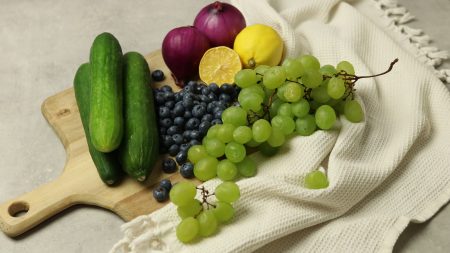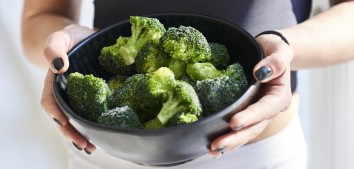
Fruit & Vegetables: Fresh or Frozen?
Many people are often concerned whether frozen fruit and vegetables are still nutritionally valuable. There is a common belief that fresh alternatives are the best choice. Whenever possible, I encourage you to choose the freshest products possible, especially now, in the summer season which is so full of omnipresent juicy fruit and crunchy veggies.
On the other hand, it is worth considering today that healthy eating should accompany us all year round, also in autumn and winter. What if the range of fresh fruit vegetables is much smaller? Did you know that by choosing frozen products, you not only save time and money, but also provide yourself with access to valuable nutrients all year round? 🙂
The Advantages of Freezing
- Inhibition of microbial growth and oxidation processes
Freezing is one of the most effective methods of storing food. Low temperature inhibits the growth of microorganisms and slows down oxidation processes, thanks to which fruit and vegetables retain their freshness, taste and nutritional value for longer.
- Long Storage Time
Thanks to freezing, you can enjoy the taste and nutritional value of fruit and vegetables not only in season, but also all year round. You can store frozen products for many months, which is especially beneficial in the case of perishable fruit and vegetables (raspberries, strawberries, blueberries, spinach, green beans).
- Lower Price
In most cases, frozen fruit and vegetables are cheaper than their fresh counterparts, which allows for significant savings, especially if you use them regularly. I recommend that you freeze your favorite fruits and vegetables during the season (when their prices are the lowest).
- Minimal Loss of Nutritional Value
Freezing causes only a slight loss of nutritional value. One study comparing the content of vitamins C, B2, E and β-carotene in fresh and frozen products (such as corn, carrots, broccoli, spinach, peas, green beans, strawberries, and blueberries) showed that the amounts of vitamins in both products were comparable . The greatest decrease was recorded in the case of beta-carotene.
- Low Costs of the Freezing Process
Compared to other valuable food preservation methods, such as freeze-drying, freezing is relatively cheap and available to most households.

Consumption of Frozen Fruit and Vegetables
Research conducted on the American market in 2015-2020 showed that people using frozen fruit and vegetables ate significantly more of them in total. Moreover, children who regularly ate frozen foods had average energy intakes significantly lower than their peers who didn’t. Lower body mass index was observed in adult consumers of frozen vegetables and fruit.
The Polish market of frozen vegetables is developing dynamically, responding to the needs of modern consumers. According to analyzes by experts from the GfK Polonia Panel, more and more Polish women and men reach for frozen foods, especially mixtures of various vegetables. Frozen vegetables are a convenient way to diversify your diet and increase your consumption of healthy products.
Practical Tips
In order to fully benefit from the benefits of frozen fruit and vegetables, you should follow a few simple rules:
- Store frozen food at the right temperature: make sure the freezer is kept at a constant low temperature to avoid defrosting.
- Follow the expiration dates: frozen foods should be eaten within the specified time period, which can be found on the product label.
- Read the labels: when choosing vegetable mixtures, pay attention to the ingredients so as to avoid products with unnecessary preservatives and unhealthy fats.
- Home freezing of fruit and vegetables: if you prepare frozen foods yourself, freeze seasonal fruit and vegetables as soon as possible after purchase, making sure they are carefully cleaned and thoroughly dried beforehand.
Frozen fruit and vegetables are a valuable, convenient and economical way to enrich your daily diet. I encourage you to take advantage of the ongoing season and fill your freezers with delicious fruit and vegetables, the taste of which you will be able to enjoy in the fall and winter 🙂
Bibliography:
- Bouzari, A., Holstege, D., & Barrett, D. M. (2015). Vitamin retention in eight fruits and vegetables: A comparison of refrigerated and frozen storage. Journal of Agricultural and Food Chemistry, 63(3), 957-962. https://doi.org/10.1021/jf5058793
- Chilczuk, B., Staszowska-Karkut, M., Materska, M., & Michałojć, Z. (2019). Zmiany zawartości witaminy C w owocach czterech odmian papryki – chłodzonych, mrożonych i liofilizowanych w zależności od okresu przechowywania. Żywność. Nauka. Technologia. Jakość, 26(1), 56-66. https://doi.org/10.15193/zntj/2019/118/273
- https://www.sadyogrody.pl/przetworstwo/105/rynek_mrozonek_2023_po_te_mrozonki_polacy_siegaja_najchetniej (dostęp: 14.06.2024)
- Piekut, J., Dec D., Zyskowska A. (2016) Zmiany zawartości związków fenolowych w wybranych roślinach przyprawowych pod wpływem procesu mrożenia. Postępy Techniki Przetwórstwa Spożywczego, 1, 32-35.
- Pobereżny, J., Wszelaczyńska, E. (2013) Wpływ metod konserwacji na wybrane cechy jakościowe owoców i warzyw znajdujących się w handlu detalicznym Inż. Ap. Chem., 52, 2, 92-94.
- Storey, M., & Anderson, P. (2018). Total fruit and vegetable consumption increases among consumers of frozen fruit and vegetables. Nutrition, 46, 115-121. https://doi.org/10.1016/j.nut.2017.08.013









Comments No Comments
Join the discussion…